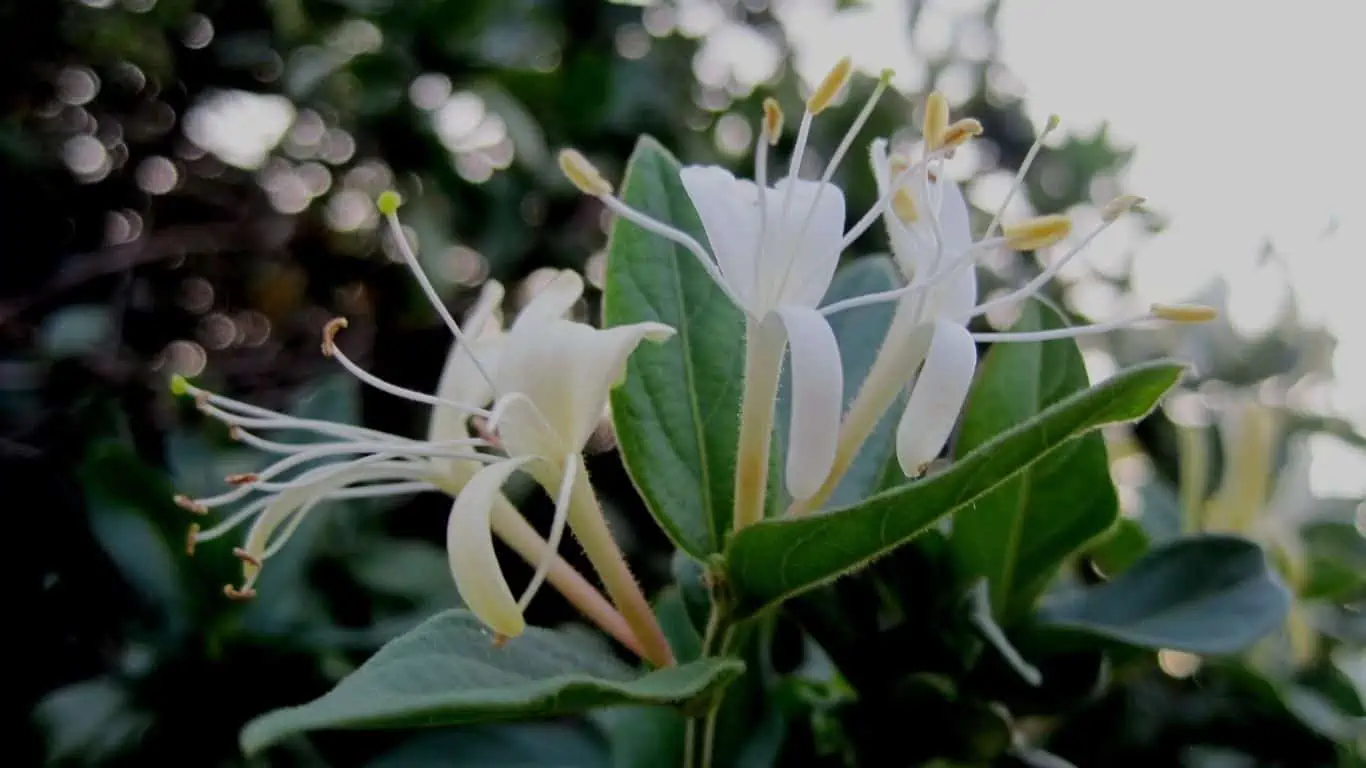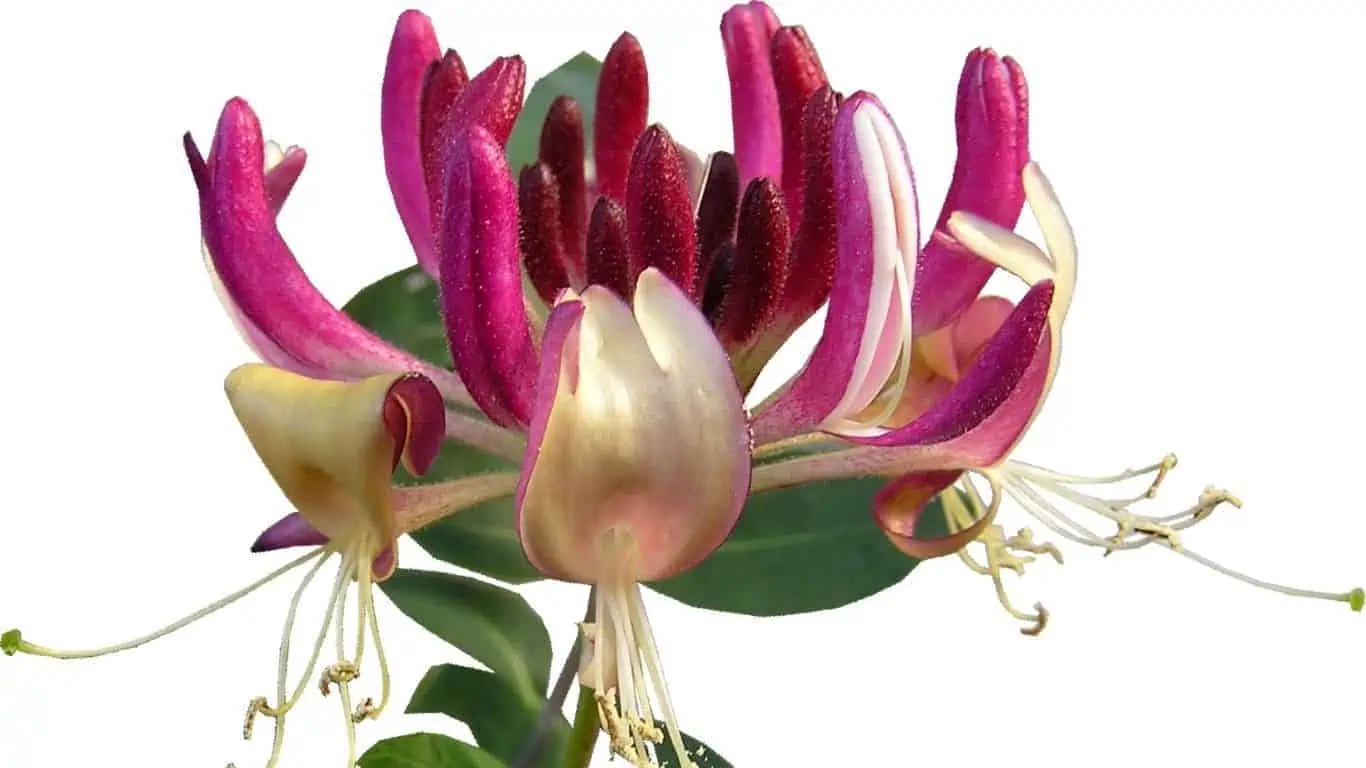Honeysuckle is an ornamental flowering plant. The plant family Lonicera spp contains all types of Honeysuckle varieties. They come in the vine as well as Bush types of plants. Most gardeners in USDA hardiness zone 4 through 9 are familiar with these beautiful fragrant flowers. they are easy to grow although susceptible to some pests problems. Today we will discuss the treatment of Insects on Honeysuckle vine leaves. If you are having a problem with these plants then keep reading for help.

Check out my previous post: Everything To know About Jasmine Plants
Which Insect Feed on Honeysuckle Leaves?
There are mainly two types of insect feed on Honeysuckle leaves. They are plant sapsuckers and the critters or leave cutters.
The plant sap-sucking insects like Aphids, Whiteflies, mealybug, and spider mites are common in Honeysuckle plants. They feed on nutritious plant sap and lead to nutrition deficiency. Severe infestations of these insects can kill the honeysuckle plant within a few weeks.
Other insects like leaf miners and caterpillars feed directly on tender leaves and systems. Caterpillars can eat multiple vines in a single day. They usually attack new stems and vines in honeysuckle during nighttime.
Some varieties of honeysuckle are hardy enough to fight against common garden pests. They can easily deal with mild pest infestation. Though none of them are 100% secure from pests and insects attacks.
These insects and pests are not alone responsible for the destruction. They carry bacteria and viruses from infected plants to healthy ones. This behavior can eventually spread deadly plant diseases throughout the honeysuckle garden.
Common Pests and Insects on Honeysuckle
Honeysuckle is a beautiful fragrant flowering plant. It is mostly grown for ornamental purposes. These plants are hardy, especially in their native hardiness zones. The Coral honeysuckle or Lonicera sempervirens is pretty hardy in USDA zone 4. They can survive cold winter and warm summer. Although none of the honeysuckle variety is fully secure from pests and insects. They are susceptible to common garden pests, especially during unfavorable climatic conditions.
Honeysuckle gardeners usually face problems with pests like-
- Aphids
- Mealybugs
- Whitefly
- Spider Mites
- Caterpillar
- Grubs
- Leaf miner
- Giant Beetles
- Stem borer
- Scales
What do Aphids on Honeysuckle look like?
Honeysuckle vine aphid or Hyadaphis foeniculi is a semi-transparent bug. It is just 1/8th of an inch in size. These bugs can vary in color although green, black and yellow aphids are common in honeysuckle plants.
Aphid is a common problem with every honeysuckle variety. They feed on the plant sap. It damages the new growth mostly due to a lack of nutrition. New shoot and flower buds often deform in absence of sufficient nutrients. The leaves start curling and wilting. The leaves turn yellow and drop off the vines. Severely infested honeysuckle plants stop their growth and become distorted and curled. Eventually, they will die if proper treatment is not done in time.
Also read: Ranunculus Asiaticus: Common Pests and Diseases
Mealybugs and Whiteflies
Mealybug and Whitefly are two very nasty bugs. They feed on plant sap and are hard to treat with common pesticides. These bugs are easy to identify as their body is covered with a white waxy substance. The covering protects them from getting in contact with pesticides. Water simple slides of their body.
These bugs start feeding on hidden corners between leaf and stem nodes. The absence of direct sunlight helps them feed and breed in these areas. They further infest the branch tips, buds, and flowers leading to a catastrophic disaster for the honeysuckle plant. the vines start curling, deforming in dying.
The easiest way to treat these waxy bugs is by removing their cover and then using pesticides. Regular rubbing alcohol is effective in dissolving their protective covering. You can use it before applying pesticides on infested honeysuckle plants.
Spider Mites
Spider mites are tiny bugs that feed on the plant ap. They attack leaves and new stem nodes. They are not so dangerous for the plant if taken care of in time. Washing the honeysuckle plants with plain water once in a while can remove these bugs.
Caterpillar and Grubs
Caterpillars and grubs are the larvae of butterflies, moths, and beetles. They feed on the tender leaves and new shoots. Grubs eat the honeysuckle plant roots. caterpillars can eat new plants overnight and mature honeysuckle within a week.
You can remove larvae manually or treat their eggs before hatching. A severe caterpillar infestation may result in skeletonized plants. The grub infestation is far worse as the plant may die by the time you notice any sign of infestation.
Leaf Miner and Stem borer
Leaf miners and stem borers are tiny insects. They are not always of the same kind instead they are the larvae of different insects. the mother bug lays eggs on the lower side of the leaves and the nodes. The larva hatches and dig deep into the stem or leaf surface and keep feeding with the available nutrients.
Tiny holes and blotches on the stem and leaves are a sign of infestation. You can simply remove the infected leaf or the stem in the early days. If the infestation continues then discarding the plant is the only option. Killing the eggs before hatching is probably the best treatment for these bugs.
Giant Beetles
Japanese giant Beetles also attack honeysuckle plants. They come in hoards of 100 or 1000 bugs at a time. These beetles are big in size and can eat every honeysuckle leaf in a single night. Japanese beetles are not native pests in the Americas. Although in last 2 to 3 decades they have spread all over the country.
Preventive measures like bug traps and active use of pesticides can help in the treatment of Giant beetles in the honeysuckle garden. Also read- Japanese Beetle: How to get rid of these bugs?- Myth Busted
Scales
Greedy Scale or Hemiberlesia rapax is a type of Armored scale that feeds on the leaves and stem of the honeysuckle plants. They are small bugs with a scale-like protective covering. These scales are dark in color and difficult to detach from their host.
Scale infestation in honeysuckle plants can lead to shunted growth with deformation and curling of leaves and stem heads. yellow, wilted leaves are a sign of scale infestation. These bugs can also spread viral and fungal diseases in the plant.
How to Get Rid of Bugs on Honeysuckle?
Your honeysuckle plants can have some insect or pest problems. They are not immune to common garden pests and insects. So you should aware of the problem and act accordingly to protect these beautiful plants.
there are three specific ways to get rid of bigs on Honeysuckle plants. These are-
- Prevention and Precaution
- Introduction of Natural predators
- Organic and Chemical Pesticide treatment
Prevention is always better than cure. If you follow proper precautions then the chance of infestation is pretty low. If any pest attacks the honeysuckle plants then you should let natural predators deal with this problem. Lacewings or parasitic wasps are helpful in this situation.
At last, if nothing works then the use of pesticides is the only option. There are two types of pesticides available for pest control, Biopesticide and chemical pesticide. You should start with biopesticides as they are safe for everyone and chemical pesticides should be your last option.
Precaution to Avoid Pests and Insects on Honeysuckle
- Avoid Water logging in the soil. Soggy soil is the home of many problems. Honeysuckle plants don’t like continuous damp soil. It can lead to fungal infection and root rot. You can protect your plant by regulating the water cycle.
- Don’t over-water your honeysuckle plants. Overwatering not only causes root rot but also attracts a lot of pests and insects toward the plant.
- Avoid splashing water on the foliage of honeysuckle plants. Splashing water can carry bacteria and fungus from the soil to the leaves and stems. This can infect and damage the plants.
- Use healthy soil mix to grow honeysuckle plants. more than 50% of plant problems are related to soil. Therefore treat the soil with fungicide. Dry it in full sun for a couple of days and then use it for plantation. You can also use the dry fry technique for container soil.
- Keep the soil clean around the rootball of the honeysuckle plant. Dead and decaying organic matter can act as a breeding ground for many pests and insects. Simple care and cleanliness can save your plants from pests and insects.
- Always grow Honeysuckle in a bright sunny spot. Dark moist and shady areas can attract Pests and insects. Proper sunlight and temperature are the natural means of pest control.
- Never grow Honeysuckle plants near open compost piles. The compost pile is a natural breeding ground for many insects. The fragrant honeysuckle flowers can attract them.
How to Treat Insects on Honeysuckle vine Leaves?
If you are careful with plantation and other garden chores then the chance of pest infestation is pretty low. Although sometimes your honeysuckle plants can face insect attacks. They are inevitable and you can’t always prevent this from happening. That’s why you should be aware of the treatment methods for pest control in honeysuckle plants.
Oil and soap water is the best treatment and protection for any infestation. Spray oil and soap water solution twice every week and keep your plants safe from common pests.
Neem oil is another biopesticide for pest control. Azardactin is the chemical extract of Neem oil. It usually doesn’t kill any pests rather the strong smell keeps them away. You can use neem oil with soap water for preventive measures.
Use rubbing Alcohol for waxy whiteflies and mealybugs. Once their wax is gone treat them with neem oil spray.
Natural predator insects like parasitic wasps and lacewing can help in controlling the population of scales, aphids, and caterpillars. They are pretty effective and are available to purchase in most garden stores.
At last, you can use any specific or all-purpose pesticide to treat insects in Honeysuckle plants. They are most effective yet a little toxic. So use chemical pesticides with proper care. Keep the pesticide away from the reach of kids and pets.

